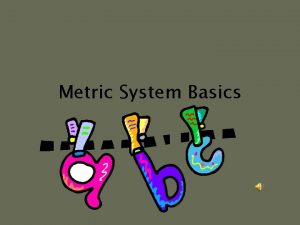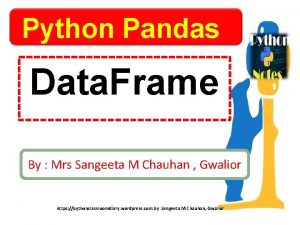INTRODUCING PYTHON PANDAS 10520 PANDAS Pandas or Python


























![S[1: ] S[1: 3] S[1: ] S[1: 3]](https://slidetodoc.com/presentation_image_h2/72d4162d1efcdc7b77f2e48096c80dab/image-27.jpg)










![import pandas as pd s=pd. Series([2, 3, 21, 12, 31, 7, 8]) s Out[3]: import pandas as pd s=pd. Series([2, 3, 21, 12, 31, 7, 8]) s Out[3]:](https://slidetodoc.com/presentation_image_h2/72d4162d1efcdc7b77f2e48096c80dab/image-38.jpg)
![s Out[7]: 0 2 1 3 2 21 3 12 4 31 5 7 s Out[7]: 0 2 1 3 2 21 3 12 4 31 5 7](https://slidetodoc.com/presentation_image_h2/72d4162d1efcdc7b77f2e48096c80dab/image-39.jpg)
![import pandas as pd s=pd. Series([2, 3, 21, 12, 31, 7, 8]) s Out[3]: import pandas as pd s=pd. Series([2, 3, 21, 12, 31, 7, 8]) s Out[3]:](https://slidetodoc.com/presentation_image_h2/72d4162d1efcdc7b77f2e48096c80dab/image-40.jpg)

![import pandas as pd s=pd. Series([2, 3, 21, 1 2, 31, 7, 8]) s import pandas as pd s=pd. Series([2, 3, 21, 1 2, 31, 7, 8]) s](https://slidetodoc.com/presentation_image_h2/72d4162d1efcdc7b77f2e48096c80dab/image-42.jpg)




![import pandas as pd s=pd. Series([2, 3, 21, 12, 31, 7, 8]) s Out[3]: import pandas as pd s=pd. Series([2, 3, 21, 12, 31, 7, 8]) s Out[3]:](https://slidetodoc.com/presentation_image_h2/72d4162d1efcdc7b77f2e48096c80dab/image-47.jpg)
![s Out[7]: 0 2 1 3 2 21 3 12 4 31 5 7 s Out[7]: 0 2 1 3 2 21 3 12 4 31 5 7](https://slidetodoc.com/presentation_image_h2/72d4162d1efcdc7b77f2e48096c80dab/image-48.jpg)
![import pandas as pd s=pd. Series([2, 3, 21, 12, 31, 7, 8]) s Out[3]: import pandas as pd s=pd. Series([2, 3, 21, 12, 31, 7, 8]) s Out[3]:](https://slidetodoc.com/presentation_image_h2/72d4162d1efcdc7b77f2e48096c80dab/image-49.jpg)

![import pandas as pd s=pd. Series([2, 3, 21, 1 2, 31, 7, 8]) s import pandas as pd s=pd. Series([2, 3, 21, 1 2, 31, 7, 8]) s](https://slidetodoc.com/presentation_image_h2/72d4162d1efcdc7b77f2e48096c80dab/image-51.jpg)



- Slides: 54

INTRODUCING PYTHON PANDAS 1/05/20 PANDAS • Pandas or Python Pandas is Python’s library for data analysis. • Pandas has derived its name from “Panel data system”, (term used for structured data sets. • It is useful for data analysis and manipulation. Data analysis: refers to process of evaluating big data sets using statistical tools to discover useful information and conclusions to support business decision –making.

• Pandas provide powerful and easy-to-use data structures, as well as the means to quickly perform operations on these structures. WHY Pandas ? It is capable of many tasks including • It can read or write in many different data formats( integer, float, double etc) • It can calculate in all ways data is organised i. e across rows and columns. • It can easly select subsets of data from bulky data sets and even combine multiple datasets together. • It has functionality to find and fill missing data.

• It allows you to apply operations to independent groups within data. • It supports reshaping of data into different forms. • It supports advance time series functionality(time series forecasting is the use of a model to predict future values based on previously observed values. ) • It supports data visualization.

DATA STRUCTURE IN PANDAS 2/05/20 DATA STRUCTURE: It refers to specialized way of storing and organizing data in a computer so that it can be accessed and we can apply a specific type of functionality on them as per requirements. Pandas deals with 3 data structure 1. Series 2. Data Frame 3. Panel We are having only Series and data frame in our syllabus

SERIES Series : - Series is a one-dimensional array like structure with homogeneous data(meaning –of the same kind), which can be used to handle and manipulate data. It is special because of its index attribute, which has incredible(Unbelievable) Functionality and is heavily mutable. It has two parts: -1. Data part(An array of actual data) 2. Associated index with data( associated array of indexes or data labels) e. g--Index Data 0 10 1 15 2 18 3 22

• Pandas data structures is enhanced versions of Num. Py structured array. • FOR WORKING IN PANDAS WE GENERALLY IMPORT BOTH PANDAS AND NUMPY LIBRARIES • Num. Py is used because in Pandas’ some function return result in form of Num. Py arrays(Pandas library’s data manipulation capabilities have been built over Num. Py library)




04/05/20 CREATION OF SERIES FROM • Ndarray • Dictionary • Scalar value

5/05/20 USE OF MATHEMATICAL FUNCTION TO CREATE DATA ARRAY IN Series().

• The Series( ) allows us to define a function that can calculate values for data sequenc • eg import pandas as pd import numpy as np a=np. arange(9, 13) print (a) [ 9 10 11 12] S=pd. Series(index=a, data=a*2) S Out[6]: 9 18 10 20 11 22 12 24 dtype: int 32




6/05/20 SERIES OBJECT ATTRIBUTES SERIES ATTRIBUTES • When we create Series all information related to it (such as size, its datatype etc) is available through attributes. • We can use these attributes in the following format to get information about the Series object. <series object>. <attribute name>

ATTRIBUTE DESCRIPTION Series. index The index(axis labels) of the series s. index Range. Index(start=0, stop=4, step=1) Series. values Return Series as ndarray-like depending on the dtype s. Values array([2, 6, 7, 9]) Series. dtype Return the dtype object of the underlying data s. dtype('int 32') Series. size Return the number of elements in the underlying data print(s. size) 4


7/05/20 Series. itemsize Return the size of the dtype of the item of the underlying data s. Itemsize 4 Series. nbytes Return the number of bytes in the underlying data print(s. nbytes) 16 (nbytes is equal to the size*itemsize) Series. ndim Return the number of dimensions of the underlying data s. ndim Out[6]: 1

ATTRIBUTE DESCRIPTION Series. hasnans Return True if there are Na. N values; otherwise return False s. hasnans False Series. empty Return True if the Series object is empty, false otherwise s. empty Out[8]: False import pandas as pd obj 1=pd. Series([]) obj 1. empty Out[14]: True

7/05/20 Series. itemsize Return the size of the dtype of the item of the underlying data s. Itemsize 4 Series. nbytes Return the number of bytes in the underlying data print(s. nbytes) 16 (nbytes is equal to the size*itemsize) Series. ndim Return the number of dimensions of the underlying data s. ndim Out[6]: 1

ATTRIBUTE DESCRIPTION Series. hasnans Return True if there are Na. N values; otherwise return False s. hasnans False Series. empty Return True if the Series object is empty, false otherwise s. empty Out[8]: False import pandas as pd obj 1=pd. Series([]) obj 1. empty Out[14]: True

8/05/20 ACCESSING A SERIES OBJECT AND ITS ELEMENTS After creating Series type object, we can access it in many ways. We can access its • indexes separately • Its data separately • Access individual elements and slices

1. Accessing individual elements • To access individual elements of a series object, we can give its index in square brackets along with its name eg Series object name [valid index]

2. Extracting Slices from Series Object • We can extract slices too from a Series object. • Slicing is a powerful way to retrieve subsets of data from a pandas object. • Slicing takes place position wise and not the index wise in a series object. Eg obj 1 position Index Data 0 Feb 28 1 Jan 31

![S1 S1 3 S[1: ] S[1: 3]](https://slidetodoc.com/presentation_image_h2/72d4162d1efcdc7b77f2e48096c80dab/image-27.jpg)
S[1: ] S[1: 3]

9/05/20 OPERATIONS ON SERIES OBJECT After creating Series type object, we can perform various types of operations on pandas SERIES OBJECTS. • Modifying Elements of Series Object • The head() and tail() functions • Vector Operations on Series Objects • Arithmetic on Series objects • Filtering Entries

1. Modifying Elements of Series Object The data values of a Series object can be easily modified through item assignment eg (a) Series object[index]= newvalue above assignment will change the data value of the given index in Series object. (b) Series object[star: stop]=newvalue above assignment will replace all the values falling in given slice





Please note that Series object’s values can be modified but size cannot. So we can say that Series object are valuemutable but size-immutable objects.


11/05/20 OPERATIONS ON SERIES OBJECT After creating Series type object, we can perform various types of operations on pandas SERIES OBJECTS. • Modifying Elements of Series Object • The head() and tail() functions • Vector Operations on Series Objects • Arithmetic on Series objects • Filtering Entries

The head() and tail() functions head(): - It is used to access the first n rows of a Series. pandas object. head() tail(): - returns last n rows from a pandas object. head()
![import pandas as pd spd Series2 3 21 12 31 7 8 s Out3 import pandas as pd s=pd. Series([2, 3, 21, 12, 31, 7, 8]) s Out[3]:](https://slidetodoc.com/presentation_image_h2/72d4162d1efcdc7b77f2e48096c80dab/image-38.jpg)
import pandas as pd s=pd. Series([2, 3, 21, 12, 31, 7, 8]) s Out[3]: 0 2 1 3 2 21 3 12 4 31 5 7 6 8 dtype: int 64
![s Out7 0 2 1 3 2 21 3 12 4 31 5 7 s Out[7]: 0 2 1 3 2 21 3 12 4 31 5 7](https://slidetodoc.com/presentation_image_h2/72d4162d1efcdc7b77f2e48096c80dab/image-39.jpg)
s Out[7]: 0 2 1 3 2 21 3 12 4 31 5 7 6 8 dtype: int 64 s. head(4) Out[8]: 0 2 1 3 2 21 3 12 dtype: int 64
![import pandas as pd spd Series2 3 21 12 31 7 8 s Out3 import pandas as pd s=pd. Series([2, 3, 21, 12, 31, 7, 8]) s Out[3]:](https://slidetodoc.com/presentation_image_h2/72d4162d1efcdc7b77f2e48096c80dab/image-40.jpg)
import pandas as pd s=pd. Series([2, 3, 21, 12, 31, 7, 8]) s Out[3]: 0 2 1 3 2 21 3 12 4 31 5 7 6 8 dtype: int 64 s. tail(3) Out[9]: 4 31 5 7 6 8 dtype: int 64

VECTOR OPERATIONS ON SERIES OBJECTS import pandas as pd s=pd. Series([2, 3, 21, 1 2, 31, 7, 8]) s Out[3]: 0 2 1 3 2 21 3 12 4 31 5 7 6 8 dtype: int 64 s+2 Out[10]: 0 4 1 5 2 23 3 14 4 33 5 9 6 10 dtype: int 64 s*3 Out[11]: 0 6 1 9 2 63 3 36 4 93 5 21 6 24
![import pandas as pd spd Series2 3 21 1 2 31 7 8 s import pandas as pd s=pd. Series([2, 3, 21, 1 2, 31, 7, 8]) s](https://slidetodoc.com/presentation_image_h2/72d4162d1efcdc7b77f2e48096c80dab/image-42.jpg)
import pandas as pd s=pd. Series([2, 3, 21, 1 2, 31, 7, 8]) s Out[3]: 0 2 1 3 2 21 3 12 4 31 5 7 6 8 dtype: int 64 s=s**2 Out[16]: 0 4 1 9 2 441 3 144 4 961 5 49 6 64 dtype: int 64

Filtering Entries import pandas as pd s=pd. Series([2, 3, 21, 1 2, 31, 7, 8]) s Out[3]: 0 2 1 3 2 21 3 12 4 31 5 7 6 8 dtype: int 64 s>15 Out[12]: 0 False 1 False 2 True 3 False 4 True 5 False 6 False dtype: bool s[s>15] Out[17]: 2 441 3 144 4 961 5 49 6 64 dtype: int 64

Arithmetic on Series objects • We can perform arithmetic like addition, subtraction, division, etc import pandas as pd s=pd. Series([2, 3, 4, 1]) s 2=pd. Series([6, 7, 8, 9]) s+s 2 Out[25]: 0 8 1 10 2 12 3 10 dtype: int 64

11/05/20 OPERATIONS ON SERIES OBJECT After creating Series type object, we can perform various types of operations on pandas SERIES OBJECTS. • Modifying Elements of Series Object • The head() and tail() functions • Vector Operations on Series Objects • Arithmetic on Series objects • Filtering Entries

The head() and tail() functions head(): - It is used to access the first n rows of a Series. pandas object. head() tail(): - returns last n rows from a pandas object. head()
![import pandas as pd spd Series2 3 21 12 31 7 8 s Out3 import pandas as pd s=pd. Series([2, 3, 21, 12, 31, 7, 8]) s Out[3]:](https://slidetodoc.com/presentation_image_h2/72d4162d1efcdc7b77f2e48096c80dab/image-47.jpg)
import pandas as pd s=pd. Series([2, 3, 21, 12, 31, 7, 8]) s Out[3]: 0 2 1 3 2 21 3 12 4 31 5 7 6 8 dtype: int 64
![s Out7 0 2 1 3 2 21 3 12 4 31 5 7 s Out[7]: 0 2 1 3 2 21 3 12 4 31 5 7](https://slidetodoc.com/presentation_image_h2/72d4162d1efcdc7b77f2e48096c80dab/image-48.jpg)
s Out[7]: 0 2 1 3 2 21 3 12 4 31 5 7 6 8 dtype: int 64 s. head(4) Out[8]: 0 2 1 3 2 21 3 12 dtype: int 64
![import pandas as pd spd Series2 3 21 12 31 7 8 s Out3 import pandas as pd s=pd. Series([2, 3, 21, 12, 31, 7, 8]) s Out[3]:](https://slidetodoc.com/presentation_image_h2/72d4162d1efcdc7b77f2e48096c80dab/image-49.jpg)
import pandas as pd s=pd. Series([2, 3, 21, 12, 31, 7, 8]) s Out[3]: 0 2 1 3 2 21 3 12 4 31 5 7 6 8 dtype: int 64 s. tail(3) Out[9]: 4 31 5 7 6 8 dtype: int 64

VECTOR OPERATIONS ON SERIES OBJECTS import pandas as pd s=pd. Series([2, 3, 21, 1 2, 31, 7, 8]) s Out[3]: 0 2 1 3 2 21 3 12 4 31 5 7 6 8 dtype: int 64 s+2 Out[10]: 0 4 1 5 2 23 3 14 4 33 5 9 6 10 dtype: int 64 s*3 Out[11]: 0 6 1 9 2 63 3 36 4 93 5 21 6 24
![import pandas as pd spd Series2 3 21 1 2 31 7 8 s import pandas as pd s=pd. Series([2, 3, 21, 1 2, 31, 7, 8]) s](https://slidetodoc.com/presentation_image_h2/72d4162d1efcdc7b77f2e48096c80dab/image-51.jpg)
import pandas as pd s=pd. Series([2, 3, 21, 1 2, 31, 7, 8]) s Out[3]: 0 2 1 3 2 21 3 12 4 31 5 7 6 8 dtype: int 64 s=s**2 Out[16]: 0 4 1 9 2 441 3 144 4 961 5 49 6 64 dtype: int 64

Filtering Entries import pandas as pd s=pd. Series([2, 3, 21, 1 2, 31, 7, 8]) s Out[3]: 0 2 1 3 2 21 3 12 4 31 5 7 6 8 dtype: int 64 s>15 Out[12]: 0 False 1 False 2 True 3 False 4 True 5 False 6 False dtype: bool s[s>15] Out[17]: 2 441 3 144 4 961 5 49 6 64 dtype: int 64

Arithmetic on Series objects • We can perform arithmetic like addition, subtraction, division, etc import pandas as pd s=pd. Series([2, 3, 4, 1]) s 2=pd. Series([6, 7, 8, 9]) s+s 2 Out[25]: 0 8 1 10 2 12 3 10 dtype: int 64

12/05/20 Q : - What is Pandas Library of Python ? What is its significance? Solution: - Pandas is a python Data Analysis library that provides data structure and functions for data manipulation and analysis. It provides fast, flexible, and expressive data structures designed to make working with labeled data in an easy and intuitive manner. It is capable of handling huge amounts od data and at the same time it provides multiple ways to handle missing data thereby making data analysis more accurate and reliable.
 Pandas ppt
Pandas ppt Introducing windows 7
Introducing windows 7 Quotes in mla format
Quotes in mla format How to introduce yourself in training session
How to introduce yourself in training session Adobe illustrator 11.0
Adobe illustrator 11.0 Introducing flex pods
Introducing flex pods An introduction to rhetoric using the available means
An introduction to rhetoric using the available means What is blood relationship
What is blood relationship Kfc overview
Kfc overview Quote starters
Quote starters Ariel trust
Ariel trust Self introduction
Self introduction Int family
Int family Khdmdcm
Khdmdcm Introducing family members in french
Introducing family members in french An organism develops active immunity as a result of
An organism develops active immunity as a result of Signal phrase
Signal phrase Templates for introducing quotations
Templates for introducing quotations Greeting and leave takings
Greeting and leave takings An introduction to the odyssey
An introduction to the odyssey Opposite numbers definition
Opposite numbers definition New market offering
New market offering What is a counterclaim in argumentative writing
What is a counterclaim in argumentative writing Introducing quotes
Introducing quotes Safe relentless improvement
Safe relentless improvement Little bio about myself
Little bio about myself Poems with literary devices highlighted
Poems with literary devices highlighted Introducing and naming new products and brand extensions
Introducing and naming new products and brand extensions Introduction to english linguistics exercises answers
Introduction to english linguistics exercises answers Templates for introducing quotations
Templates for introducing quotations Letter to exchange student
Letter to exchange student Introducing internet
Introducing internet As he himself puts it the art of quoting summary
As he himself puts it the art of quoting summary Introduce yourself sample
Introduce yourself sample Chapter 1 introducing psychology
Chapter 1 introducing psychology Government in america chapter 1
Government in america chapter 1 Introducing neeta anil said
Introducing neeta anil said Relocation diffusion definition
Relocation diffusion definition Alimentary canal
Alimentary canal Introducing james joyce
Introducing james joyce Introducing and naming new products and brand extensions
Introducing and naming new products and brand extensions Introducing the metric system
Introducing the metric system Introducing broker vs carrying broker
Introducing broker vs carrying broker Pandas structural adaptations
Pandas structural adaptations Tic-oireiden helpottaminen
Tic-oireiden helpottaminen Pandas
Pandas Are pandas the national animal of china
Are pandas the national animal of china Of pandas and people
Of pandas and people Acrostic poem for lily
Acrostic poem for lily Yellow throated marten attacking a panda
Yellow throated marten attacking a panda Panda exposé
Panda exposé Non chronological report on panda
Non chronological report on panda Pandas _____________ fly.
Pandas _____________ fly. Pandas
Pandas Zespół pandas objawy
Zespół pandas objawy














































































